|
 |
|
|
|
|
|
|
Welcome to Spaightwood Galleries, Inc.
120 Main Street, Upton MA 01568-6193
You can follow us on Facebook at http://www.facebook.com/andrew.weiner.16
and http://www.facebook.com/pages/Spaightwood-Galleries-Inc/122951564441757
|
|
|
|
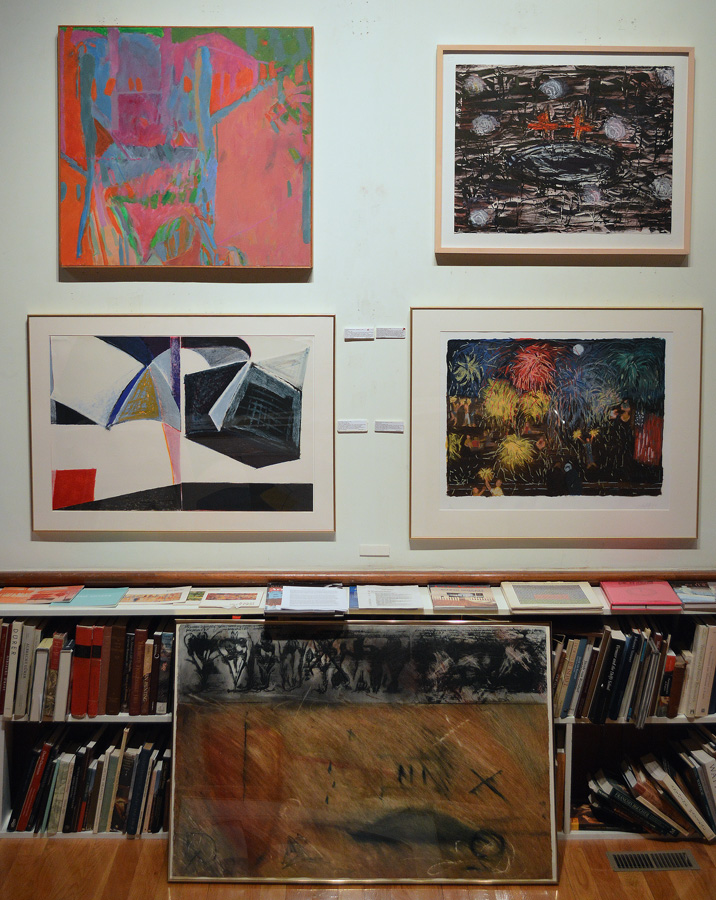 |
|
|
|
Upper right: Suzanne McClelland (American, b. 1959), Untitled (click title for enlargment), Oil on canvas, 1980. Suzanne McClelland,whose work is currently being featured in the 2014 Whitney Biennial at the Whitney Museum of Art in NYC ), is here represented by a work that was included in the exhibition Panorama '80. The work is signed and titled in pencil on the reverse. McClelland's work is featured in the March 2014 Art in America, pp. 106-115. Image size: 812x863mm. Frame size: 31-7/8x34 inches. Price: Please call or email for current pricing information.
Upper left: Joan Snyder (American, b. 1940), Field of Moons (Symmes 44; (click title for enlargment). Original monoprint (color etching, aquatint, & woodcut), 1993. This is part of a series of 8: hand-inked and selectively printed in various media, including oil paint and pastel; they were subject to multiple printings and hand-coloring, each one of the 8 impressions is thus a unique variant and is annotated 1/1 lower left and signed lower right. Originally published in "The New Provincetown Print Project Portfolio." Image size: 565x711mm. Mat size: 38x34-5/8 inches. Price: Please call or email for current pricing information. For more on Joan Snyder, click here.
Lower right: Susan Crile (American, b. 1942), Back and Forth (T. 82-613; (click title for enlargment). Original color lithograph printed and published by the Tamarind Institute, 1982. 40 signed & numbered impressions. Crile is a painter and printmaker whose work is featured in A Graphic Muse, and she has had numerous one-person shows throughout the U.S. Her wprks are included in a number of U.S. museums including the Albright-Knox Museum in Buffalo, NY. This work was printed at the Tamarind Press. Image size: 614x920mm. Mat size: 30x42 inches. Price: Please call or email for current pricing information.
Lower left: Jennifer Bartlett (American, b. 1941), Earth Fireworks (Art at Lincoln Center, p. 181; (click title for enlargment). Original 26-color serigraph, 1996. 105 signed & numbered impressions. Bartlett is one of the most important American painters and printmakers of her generation. Her work frequently explores different ways of seeing a given place or object. Commissioned by Lincoln Center for the Performing Arts in NY CIty and published by them. One of her most beautiful prints. Image size: 575x775mm. Mat size: 30x42 inches. Price: Please call or email for current pricing information.
Leaning against the bookshelves: Anita Jung (American, b. 1960), Persephone (original monotype: etching, aquatint, and hand-painting; click title for enlargment) was the Greek goddess of Spring (her Roman name was Proserpina), daughter of Ceres (her Roman name was Demeter), goddess of Agriculture, and Zeus. Hades, the ruler of the underworld saw her, loved her, kidnapped her, and brought her down to his domain. After Ceres threatened to stop all plants from growing, Hades compromised and allowed her to spend half the year with him and the other half on earth. Anita Jung received her MFA from the University of Wisconsin, Madison. She also worked as a master printer at Bill Weege's Off Jone's Road Print Shop and at the Tandem Press of the University of Wisconsin. She is currently a Professor of Art at the University of Iowa where her specialty is printmaking. Her work has been shown in the US and abroad. For more of her works, please click here. Image size: 800x1210mm. Frame size: 33x49inches. Price: Please call or email for current pricing information.
For a web-tour of the large images in the show, please click here.
|
|
|
|
Given the size of our website (currently 742 web-pages long), we have decided to start a listing of recent additions or revisions to pages on our website to make it easier for visitors to find new listings.
Today I uploaded revised versions of the 16 web-pages devoted to the paintings, drawings, aquatits, lithographs, and screenprints of Claude Garache. Click here to begin exploring his works.
Also recently revised: Lynda Benglis, Louise Nevelson, Joan Mitchell, Helen Frankenthaler, Nancy Graves, Anita Jung, Susan Rothenberg, Jennifer Bartlett, Dorothea Tanning, Jane Freilicher, Nataliya Goncharova, Elaine de Kooning, Joan Snyder, Pat Steir, Niki de St. Phalle, and Judy Pfaff. More to come soon. . . .
Yesterday was the day for photographing works for the show, but I also updated the four Joan MItchel pages, begining at Mitchell (please follow the links from there for the other 3 Mitchell pages). Sunday's 10 revised pages were: Francesco Albani, Sam Gilliam, Louise Bourgeois, Don Reitz, René Magritte, Joan Miro (1974-1979), Judy Chicago, Gerolamo Scarsello, Aristede Maillol, and Rembrandt. We are in the process of updating all of our Alechinsky pages; look for them to come fairly soon.
News of Spaightwood Galleries: Pierre Alechinsky: The Year of the Snake is fully de-mounted upon the walls (all 98 pieces, some of them quite large) with another 22 works in frames and leaning against the book shelves over which the other works are hung (we also have a number of other works that are available for viewing but not on display, but our usuable vertical space is about 8 feet above the 2-tiered book shelves). Please go to our home page for more about the Alechinsky show and a taste of all of our shows since our arrival in Upton.
We are on Facebook! Please visit our Spaightwood Galleries Facebook page:
https://www.facebook.com/pages/Spaightwood-Galleries-Inc/122951564441757
for daily postings of art and art news.
Please feel free to "Like" us at either our gallery page or our personal page or at both locations!
33 years ago last Thanksgiving, we mounted our first exhibition, a Miró show featuring about 30 original lithographs, most from deluxe art reviews, but with several signed and numbered works as well. Following that show, we presented works by Chagall purchased on a 1980 trip to Paris in the expectation of opening a gallery within our home. The show included many of Chagall's etchings for the Dead Souls, The Fables of La Fontaine, and the Bible as well as original lithographs from Derriere le Miroir, XXe Siecle, and Verve. We quickly discovered that we were filling a gap in the Madison WI art scene, which largely focused on works by local and regional artists, artists connected to the University of Wisconsin–Madison, and a sprinkling of works by national and international artists. Quickly converting income from sales into yet more art from artists like Valerio Adami, Pierre Alechinsky, Joan Gardy Artigas, Jim Bird, Claude Garache, Alberto Giacometti, Manel Llèdos, Joan Miró, Pablo Picasso, Pierre Tal-Coat, Antoni Tàpies, Gérard Titus-Carmel, Bram van Velde, and the American contemporary artists who most shared their interests, Helen Frankenthaler, Joan Mitchell, Robert Motherwell, and Louise Nevelson, we began to build our inventory. Our low overhead (we showed out of our National Historic Register home in Madison until 2004 when we moved into our present space in Upton MA) allowed us to take risks, and we quickly branched out to works by the experimenters of the late-19th and the early 20th centuries, artists associated with the Impressionists, the Post-Impressionists, the Nabis, Georges Rouault and the Fauves (for links to all of these artists, click here), who led us to German Expressionism (especially Lovis Corinth, Otto Dix, Georg Grosz, Erich Heckel, Hannah Höch, Karl Hofer, Wassily Kandinsky, Ernst Ludwig Kirchner, Paul Klee, Max Pechstein, Karl Schmidt-Rottluff, and Georg Tappert), and to the works of their contemporaries, Oskar Kokoschka, Käthe Kollwitz and Ernst Barlach. We also found ourselves fascinated by the Surrealists (starting with Miró, who led us to his former assistant, Louise Bourgeois, as well as to Lucien Coutaud, Leonor Fini, Stanley William Hayter, Wifredo Lam, Réné Magritte, Matta, Masson, Pablo Picasso, Graham Sutherland, Dorothea Tanning, Toyen, and Paul Wunderlich) and the artists of COBRA (especially Alechinsky, Karel Appel, Corneille, Asger Jorn, Bengt Lindstrom, and Lucebert, and we showed their works as well. Every now and then, an artist would appear and we would fall in love with their works (as in the cases of Jonna Rae Brinkman, Warrington Colescott, George Cramer, Nancy Graves, John Himmelfarb, Pat Steir, Wayne Taylor, or Emmi Whitehorse). Our own collecting had started with the our love for the woodcuts and engravings of Albrecht Dürer (initially facilitated by our discovery in Paris of a large number of impressions from Dürer's Das Narrenschiff (The Ship of Fools) and our discovery in the shop of a British bookseller of an 1844 edition of The Small Woodcut Passion published by the director of the South Kensington Museum (now known as the Victoria and Albert Museum) from stereotype casts made from Durer's original woodblocks after they were acquired by the British Museum in 1837; our Dürer collection has since been augmented by many impressions of prints from all of Durer's major series (The Apocalypse, The Large Passion, The Small Woodcut Passion, The Life of the Virgin, and the Engraved Passion), including many early impressions from the 1511 Latin editions of The Life of the Virgin, The Large Woodcut Passion, The Small Woodcut Passion, and The Apocalypse, the first appearances in final form of these works in book form with printed text on the reverse of the major series. We also have a number of superb early proofs before the first editions as wll as very good later 16th century impressions. In addition, we also have an almost complete set of Marcantonio Raimondi's engravings after Dürer's Small Woodcut Passion as well as several other Renaissance copies after Dürer's prints. At this point, our holdings of old master drawings (the subject of our recent show) and old master prints comprise over 20% of our over 9000 works in inventory.
Speaking of old master drawings, one of the artists whose work is featured in our recent show was Perino del Vaga, one of Raphael's assistants, who had a very big week at the auctions at the end of January 2011. According to The New York Times: "On 26 January 2011, The Metropolitan Museum of Art set a new world record for a drawing by Perino by paying Please call or email for current pricing information for a drawing for a tapestry of Jupiter and Juno Reclining in an Alcove. The prior auction record for a drawing by Perino was Please call or email for current pricing information." The next day, the Met bought The Holy Family With the Infant St. John the Baptist,” a painting by Perino, for Please call or email for current pricing information million. It had been expected to bring Please call or email for current pricing information to Please call or email for current pricing information. "It was a double sweep,” Keith Christiansen, the Met’s chairman of European paintings, said in a telephone interview. “Perino del Vaga is one of the very great Renaissance draftsmen, but the minute I saw this painting, I nearly keeled over.” For our drawing by Perino, please click here. After living with the old master drawings for a while, we decided to make use of the upper tier on our walls (they are over 10 feet high from and added a show of paintings, aquarints, and a drawing by Claude Garache to the mixture. To our delight, Garache, who was called the first post-modern artist of the nude back in the early 1960s, turns out to be completely classic as well. Like Michelangelo, he believes that meaning is to be found in bodies, and his bodies are deeply moving. He works with women's bodies not just because he is a man and a Frenchman to boot, but because he believes that women's bodies are mnore universal—more human—than men's. For an imcomplete tour of the show, click on Gallery Tour 1 above (or here); Gallery Tour 2 is not yet complete (we got distracted by Goya nand Grosz), but you can see the part is done by clicking here.
Speaking of Grosz, we managed to purchase a partially disbound exemplar of the first (and only) edition of Ecce Homo (Ausgabe C from the first edition). The complete set consists of 16 offset color lithographs after watercolors and 84 offset lithographs after drawings. After seeing 3 of them in a wonderful show of Beckmann, Dix, and Grosz at Gallerie St. Etienne in NY City, we were struck once again by the power of Grosz's drawing. Grosz himself anticipated his place in the history of art. After relocating to the U.S., Grosz wrote in 1938 to J. B. Neuman concerning his work: "My drawings will naturally stay true–they are fireproof. They will later be seen as Goya's work [is]. They are not documents of the class struggle, but eternally living documents of human stupidity and brutality." At the moment, we have all 16 of the color pieces and the first 62 of the black and white pieces (all of which are available; we have the other 22 pieces, but they are not yet posted on our website. Soon!). You can browse them by clicking here for the first of two pages devoted to the color pieces or here for the first 7 pages devoted to the black and white pieces. We do have all of our too brief exhibit of our show of the fall of 2013 devoted to thinking about war. It included a complete set of the 80 mixed-media intaglio prints from the 4th edition of Goya's Disasters of War plus the first printing of plate 81, which was considered too controversial tp publish during the 19th century. The show also included the 16 color plates from George Grosz's Ecce Homo, 27 of the mixed-media intaglio's from Rouault's Miserere, and 31 of Otto Dix's lithographs for The Gospel According to St. Matthew. For a tour of the show, please click here.
|
|
|
|
|
|
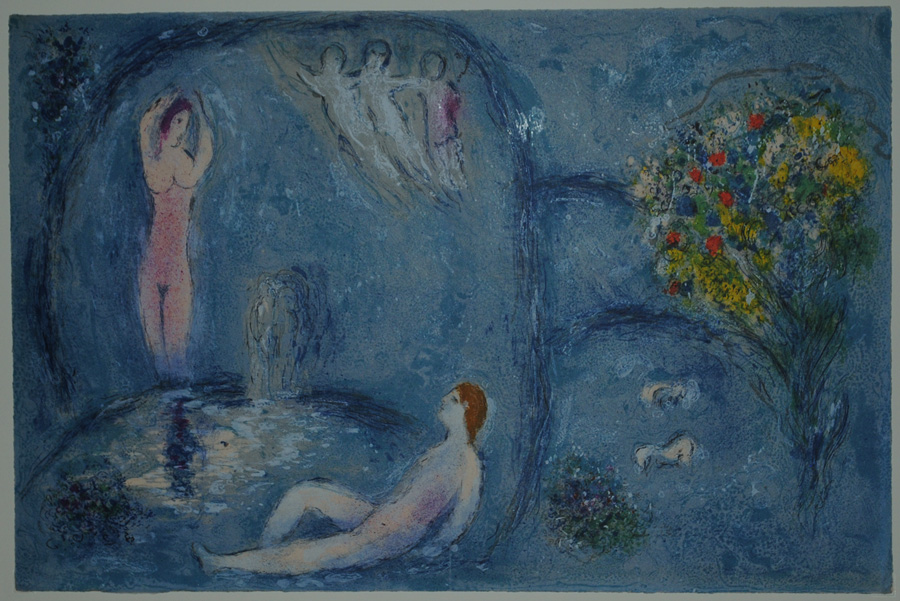 |
|
|
|
I am delighted to announce a brand-new acquisition (though one we have been hoping for over the past nearly 40 years). Marc Chagall, The Cavern of the Nymphs (M. 321). Original color lithograph, 1961. 250 unsigned impressions on Arches paper for the deluxe portfolio, Daphnis and Chloe (there were also XX portfolios HC numbered from I to XX). Each of the portfolios was signed, but not the individual sheets. In addition to the portfolios, there were also 60 signed and numbered impressions with wide margins of each of the 40 original color lithographs in the suite, 26 of which had images that were about 320x460mm and 16 were double pages with a centerfold whose images measured about 420x640mm (of which ours is one). Chagall's lithographs illustrating the story of Daphnis and Chloe (as told in Longus' 2nd-century Greek romance of the same title) are among his most famous and most desired lithographs. The lithographs were printed in Paris by Fernand Mourlot and the portfolios were published by Tériade Éditeur. The introduction to the section devoted to Daphnis and Chloe in volume II of the catalogue raisonné of Chagall's lithographs describes the portfolio as "the most important graphic work realized by Marc Chagall to this day" (published in 1963). 124 works from Daphnis and Chloe have been sold at auction since May 1992 (or about 6 per year), of which only two were The Cavern of the Nymph (M. 321). Both of those were from the edition of 60 signed and numbered impressions. One sold for Please call or email for current pricing information (in 2007); the other sold for Please call or email for current pricing information (in 2006). By comparison, another double page image, The Temple and History of Bacchus sold three times: a signed and numbered impression sold for Please call or email for current pricing information (in 2012); an unsigned artist proof sold for Please call or email for current pricing information (in 2007), and another signed and numbered impression sold for Please call or email for current pricing information (in 2006). A slightly better comparison may be in the sales of 2 impressions of Hymen, the god of marriage, one of which sold for Please call or email for current pricing information (in 2006) while an unsigned impression sold for Please call or email for current pricing information (in 2007), or about 24% of the signed impression. Using that ratio, our unsigned impression might realize about Please call or email for current pricing information at auction. A very good impression of one of the most beautiful original lithographs in the whole Daphnis and Chloe suite. Image size: 417x633mm. Price: Please call or email for current pricing information.
|
|
|
|
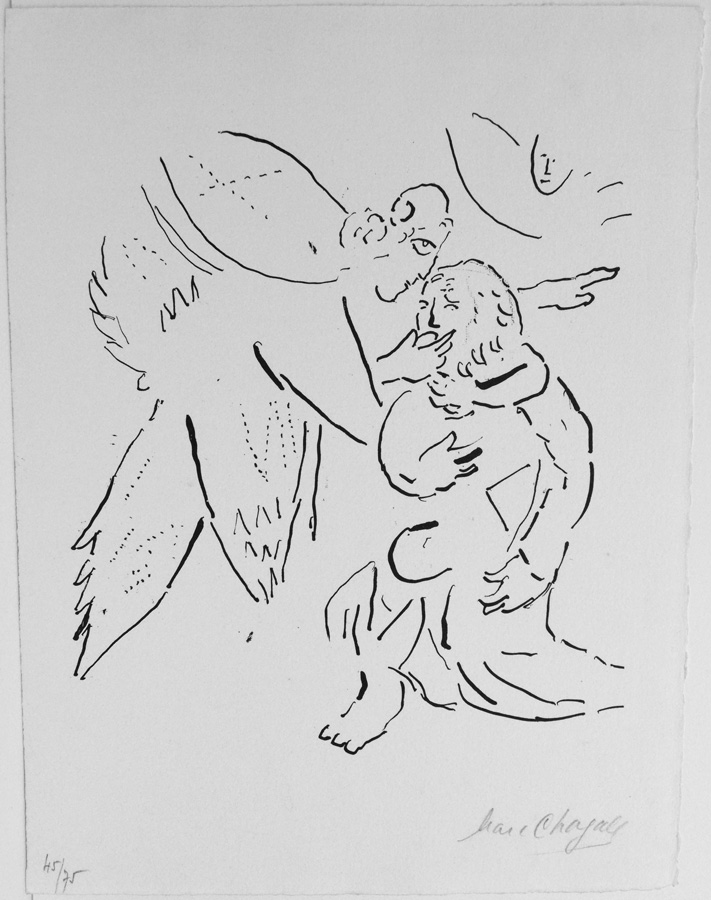 |
|
1956 marked the end of a long artistic journey for Chagall. In 1930, Ambroise Vollard had invited him to make a set of etchings for the Bible. After a trip to Palestine, Chagall began to work, creating 105 etchings between 1931 and 1939 and completed bertween 1952 and 1956, which were ulitmately published by Teriade in 1956 in a dual edition: 295 black-and-white etchings for the book edition (each of the books were signed; none of the prints in the regular edition, included unbound in their own removable folder, were signed) and a separate deluxe edition of 100 hand-painted etchings by Chagall that were signed and numbered (see above for an example). To celebrate the completion of this long awaited project, Teriade, the publisher of Chagall's three great artist's books—The Dead Souls (1948), The Fables of La Fontaine (1952), and The Bible, who was also the publisher of the deluxe art review, Verve, persuaded Chagall to create 17 color lithographs on the theme of the Bible as well as 12 original black and white lithographs that were printed on the reverse side of the lithographs devoted to Moses, David and Solomon, and the prophets Jeremiah, Isaiah, and Daniel for a special number of Verve devoted to Chagall's Bible etchings. These twelve black-and-white lithographs were also issued in an edition of 75 on large sheets of Arches paper, but only five of them were pencil-signed and numbered by Chagall, one of which is Isaiah ddivinely inspired (M. 141). Edition: circa 6500 unsigned impressions printed on the verso of Isaiah (M. 146) and 75 signed and numbered impressions on Arches paper of which ours is n. 45. Image size: 403x305mm. Price: Please call or email for current pricing information.
|
|
|
|
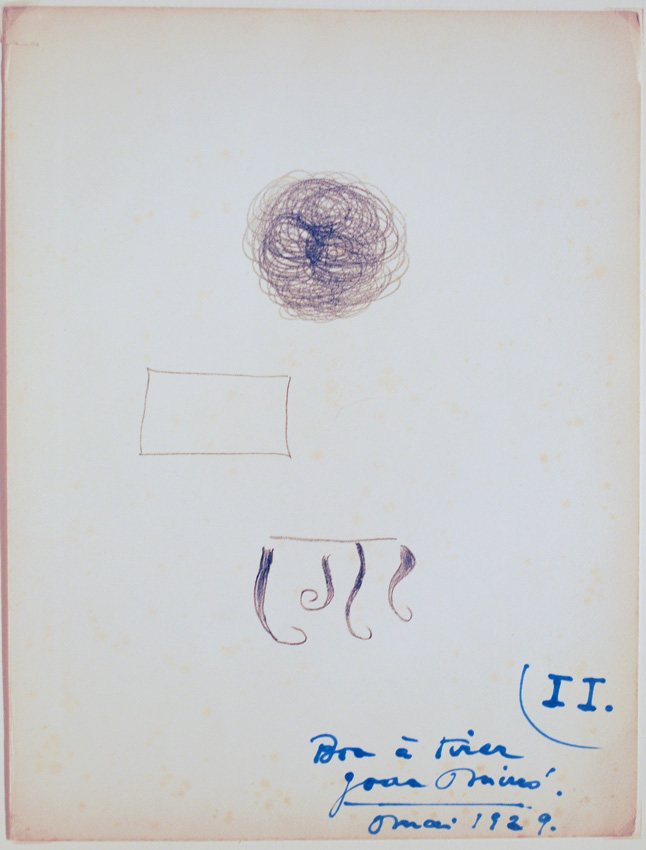 |
|
Miro's Lithograph I (it did not otherwise have a title), was a stand-alone work published by Christian Zervos in Paris in 1930. Since two of our impressions are dated 1929, it seeems likely that these actually should be counted as Miró's first four lithographs, executed in 1929 to accompany a a poem, L'Arbre des Voyageurs, by his friend, the Surrealist poet Tristan Tzara—with whom he would collaborate again in a set of etchings in 1947 for L'Antitête—published in 1930 in an edition of 101 impressions. They are among his most Surrealist works. Each of the books was signed but the individual lithographs were not. Compared to many of Miró's later illustrated books, this one is on the small side, measuring 9-3/4 x 6-3/8 inches. In addition, there was a separate printing of each of the lithographs in a numbered edition of 10. We present the complete set of 4 in the Bon à tirer proofs, the first of which is signed by Miró and dated 1929. These four impressions, Miró's final versions of the lithographs, were meant to serve as models for the printers when printing the rest of the edition. They were printed on heavy wove paper of varying sizes but substantially larger than the pages of the book edition. The first of these, L'Arbre des Voyageurs I (M. 2), is signed in blue ink and labeled Bon à tirer and numbered II lower right. There is some foxing on the sheet (the other 3 sheets are clean). L'Arbre des Voyageurs was Miró's first artist's book. Image size: 358x272mm (14-1/8x10-11/16 inches). Price: Please call or email for current pricing information.
For the other piepces in this series, click here.
|
|
|
|
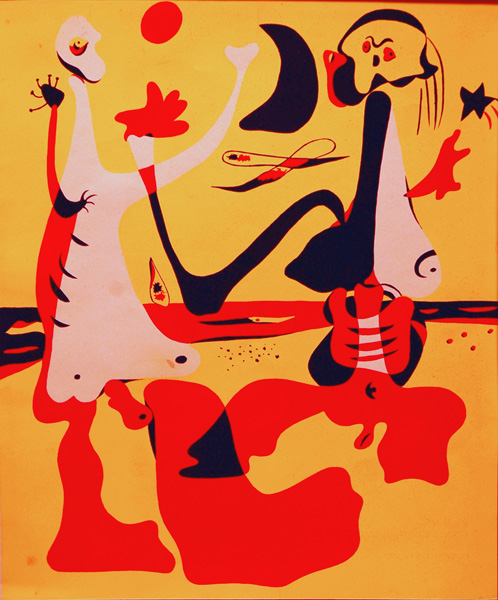 |
|
|
|
Joan Miró (Spain,1893-1983), Personnages devant la mer / Figures by the sea shore (Dupin 13). Original color pochoir, 1934. Published in December 1934 in the art journal D'Aci i D'Alla; printed by J. Mateu, Pochoir Publicity Art, Barcelona, 1934. The number impressions of this pochoir is unknown, as is the number that might have been destroyed during the Spanish Civil War soon to follow, What we do know is that impressions of this piece are rarely available in the art market (this is only the second impression of this early color lithograph that we have seen since 1975). This is one of Miró's most surreal prints showing a male and a female figure reaching out for each other in lust or terror while the leg of the female figure on the right seems to interpenetrate the leg of the male figure on the left. A rare and beautiful print with the surface texture of a gouache slightly marred by two small flaws in the shape of spots in the lower left corner by the heel of the male figure and on the right side of the white torso of the male figure. The spot on the torso is not red but gray; the spot by the heel is a discoloration slightly darker than the yellow where it occurs. Image size: 315x245mm. Price: Please call or email for current pricing information.
|
|
|
|
|
|
 |
|
|
|
Marc Chagall (Russia, 1887-1985, France), Behind the Mirror (M. 412). Original color lithograph, 1964. 75 signed & numbered + c. 2000 unsigned impressions. Commissioned for the deluxe art review, Derrière le Miroir, this lithograph explores a theme of great interest in surrealist art, the mirror as pathway to another world. The presence of the clown and the acrobat at either end of the mirror also suggests the circus as a place where we go to be thrilled by shows that we know are not true, hence the staid matron who imagines herself as a high-wire artist, hanging on to the mirror with her hands while her legs are up over her head. With the centerfold, as always. Image size: 345x465mm. Price: Please call or email for current pricing information; sale price (until until Valentine's Day): Please call or email for current pricing information.
|
|
|
|
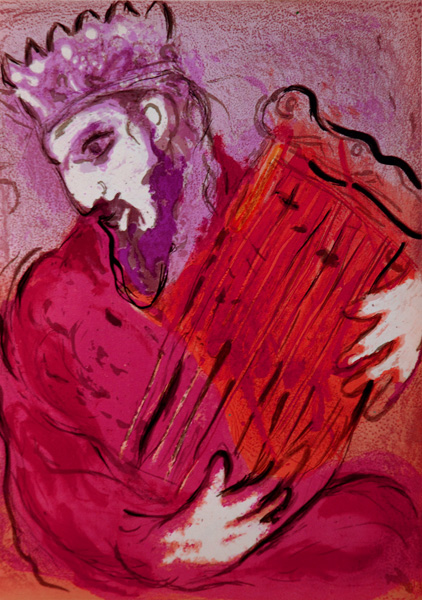 |
|
|
|
Marc Chagall (Russia, 1887-1985, France), David with his harp (M. 133). Original color lithograph, 1956. 75 signed and numbered impressions plus 6500 unsigned impressions as ours. Illustrated in the catalogue for the 1973 Musee National Message Biblique Marc Chagall inauguration. Our impression was recently illustrated on the cover of Anthony Phillips, David: A Story of Passion and Tragedy (London: SPCK, 2008). Image size: 355x260mm. Price: Please call or email for current pricing information.
|
|
|
|
|
|
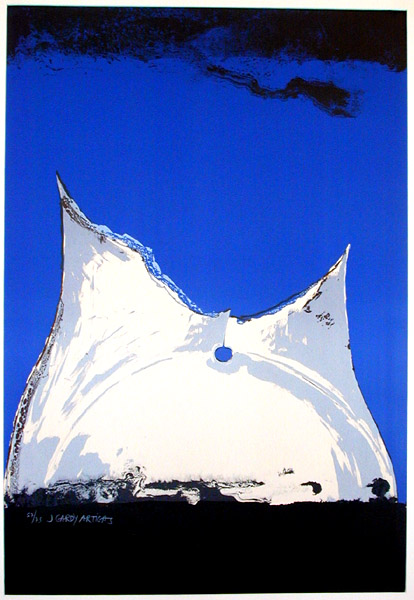 |
|
|
Joan Gardy Artigas (Spanish, b. 1938), Platre / Plaster. Original color lithograph, 1968. 75 signed and numbered impressions published by Maeght Editeur in Paris. This work is related to a series of fragmentary plaster sculptures Artigas was making at the time. One of Artigas' earliest lithographs, the image offers a glimpse at the mysterious process involved in the creation of ceramic sculptures as the wood-fired kiln turns the soft and malleable clay into the stone-like yet vulnerable surface of the ceramic sculpture. Artigas has explained his love of lithography as follows: "If I want power, impact, a startling image, I use lithography. With the technique of printing directly off the stone, it is possible to get a maximum of ink on the paper. This . . . allows . . . powerful color." Image size: 865x595mm. Price: Please call or email for current pricing information.
|
|
|
|
|
|
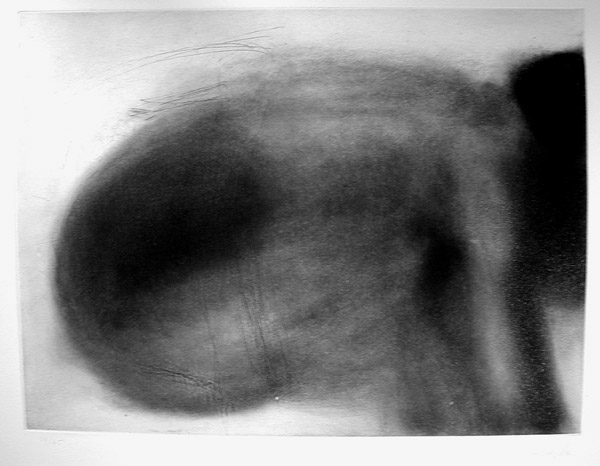 |
|
|
|
Claude Garache (French, b. 1929), Gaume. Original color aquatint with etching, 1972. 45 signed & numbered impressions. Illustrated in Argile V (1974), in Claude Garache: Prints 1965-1985, ed. Richard Stammelman and Jean F. Feinberg (Ezra and Cecile Zilkha Gallery, Wesleyan University, 1985), and in Jean Starobinski's Garache (Flammarion, 1988). Image size: 300x400mm. Price: Please call or email for current pricing information.
|
|
|
|
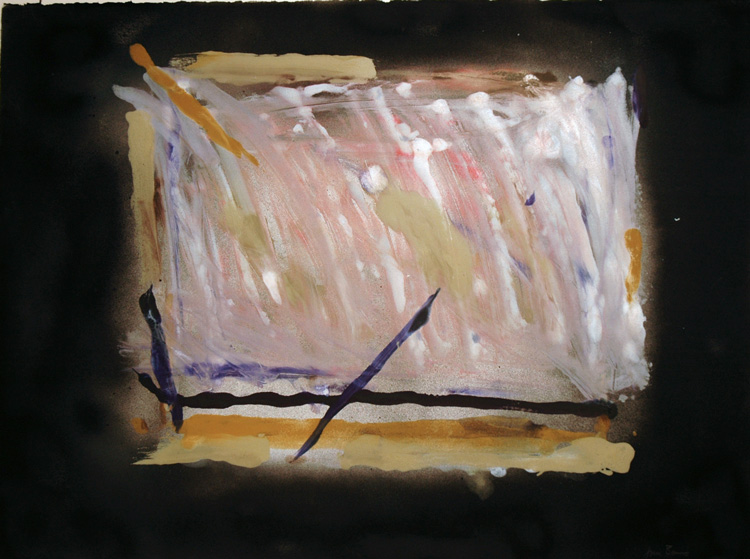 |
|
|
|
Jim Bird (English, 1937-2010), Madison Series 93. Mixed media, 1987. These works combine monotype, acrylic, oil stick, pastel, and other media on Arches paper. They might be best described as exploring the space between painting, drawing, and print-making. Image size: 574x768mm. Price: Please call or email for current pricing information.
|
|
|
|
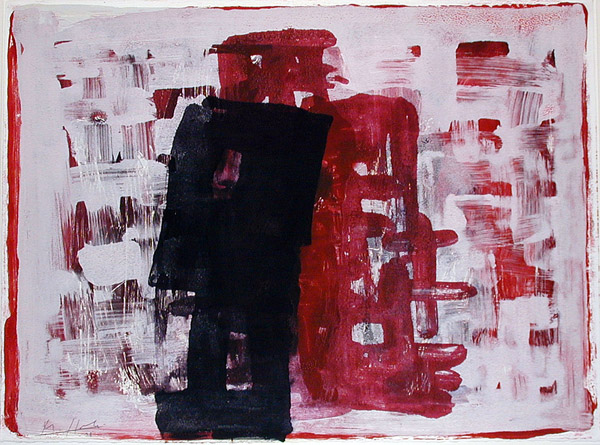 |
|
|
|
Manel Llèdos (Spanish, b. 1955), Stoughton Series A. 11. Original color monotype, 1991. Edition: One of a series of monotypes printed at Wayne Taylor's Stoughton Atelier and published by Spaightwood Galleries. Signed in pencil lower left. Image size: 575x770mm. Price: Please call or email for current pricing information.
|
|
|
|
SHOWS SEEN: 2010 |
|
|
|
MAN, MYTH, AND SENSUAL PLEASURES: JAN GOSSART'S RENAISSANCE (Metropolitan Museum of Art, through January 17, 2011): A gorgeous blockbuster show that spawned a wonderful huge book about the marriage of late 15th-century Netherlandish art with early Italian Renaissance Art. The book also offers a complete catalogue of Gossart's paintings, drawings, and prints. We spent 5 hours going through the show and found it exhausting but exhilarating. I haven't had time to work with the book yet (we were working on our old master drawings show until recently), but if the book is as intelligent as the show, it will be impressive indeed.
OTTO DIX, through 30 Aug. 3010. "The first Dix retrospective in this country provides heady glimpses of the achievement of this so-called wild man of German art. Few things escaped his remorseless eye — from the horrors of World War I to the hypocrisies of the Weimar Republic. He made every stop on the itinerary of German modernism (including Realism, Dada, Surrealism, Expressionism, folk, visionary), had a few Cubist moments and, of course, qualified as degenerate under the Nazis. This exhibition of more than 100 paintings, prints, watercolors and drawings (organized with the Montreal Museum of Fine Arts) doesn’t have the scope — or the space — to do Dix justice, but it begins to make up for lost time." Neue Galerie, 1048 Fifth Avenue, at 86th Street , (212) 628-6200, neuegalerie.org." We saw this show back in May, and it was stunning. We had seen a show in Paris in Nov. 2007 at the Musée Maillol entitled Allemagne, les années noires devoted to the works of Max Beckmann, Otto Dix, Walter Gramatte, Georg Grosz, and Ludwig Meidner during and immediately after the first World War. Dix stole the show. In addition to showing all 50 etching in the series Krieg / War, it also included a series of drawings done on postcards which all German soldiers were required to use to let their friends and relatives know that they were alive and that the war was proceeding successfully. Dix used these roughly 4x6 inch cards to making searing drawings of dead bodies, maimed bodies, and ruined landscapes, many of which apparently were sent on through the mails (so much for morale? so much for censors?). The war etchings were incredibly disconcerting, and seeing them all lined up in the museum was an invitation to an incredibly moving and painful meditation on war, perhaps comparable only to Goya's Disasters of War, the large mixed media intaglios in the Guerre section of Rouault's Miserere, or Picasso's Guernica. Although the show in Paris included a small selection of gouaches and paintings from after the war, its focus was clearly upon Dix's war etchings and drawings. The show at the Neue Galerie also includes all 50 the the Krieg etchings, but most of it is devoted to Dix's paintings and gouaches of Germany during the late teens and the early '20s, when Dix was the most sought after portrait painter with the avant-garde set. This huge show (more than 170 works taking over most of the Neue Galerie's space) , though it also contains some stunning landscapes, mostly focuses upon the survivors of the war and those who became rich from it, the physically crippled and the morally damaged. If you cannot get to New York City before the show ends, you can still see it in the superbly-illustrated catalogue of the show, Olaf Peters, ed., Otto Dix (NY: Prestel, 2010). We, alas, do not have any of the Krieg etchings or any of Dix's drawings, gouaches, or paintings. What we do have, however, are the 33 black and white lithographs he did in 1960 for an edition of The Gospel according to Matthew. In these lithographs, Dix uses the Gospel story as a model for interpreting events: they contextualize the present day's horrors against the meaning provided by the whole of the story of which they are a part. While they lack the searing intensity of the etchings for Der Krieg, they provide a deeply moving testament to the biblical story of how a state or a church can turn upon itself and destroy those who embody its best hopes.
|
|
|
|
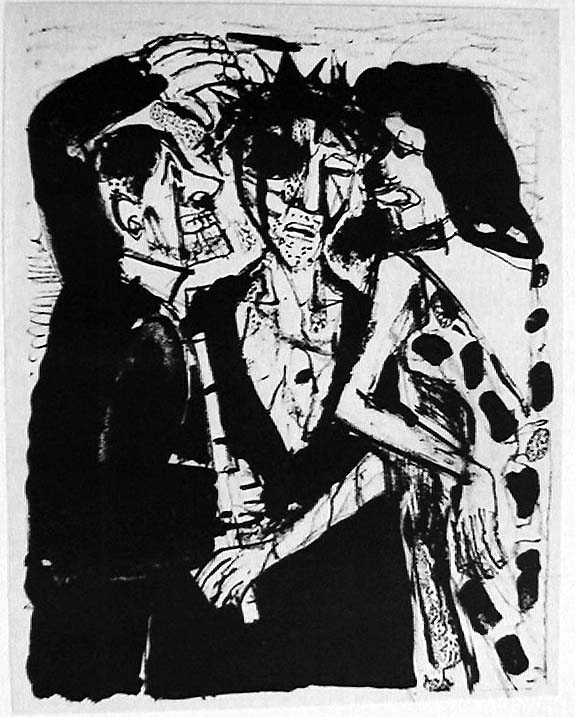 |
|
|
|
Otto Dix, Die Verspottung / Christ mocked (Karsch 263). Original lithograph, 1960. 2000 impressions published in Das Evangelium nach Matthäus. Here the mockers wear the fashions of 20th-century Germany, particularly the woman wearing an evening gown and sticking her tongue out at Jesus in a childish gesture of contempt. Image size: 290x223mm. Price: Please call or email for current pricing information.
|
|
|
|
ALBRECHT DURER: Purely in terms of the number of visits we made to it, the recently closed exhibition of Dürer masterpieces at the Boston Museum of Fine Arts has to rank as our favorite show of the past year. Although there was, alas, no catalogue for the show, the 40+ woks in the show were all masterpieces in superb impressions. Woodcuts from The Apocalypse (1498 and 1511), The Large Passion (first published as a set in 1511; individual pieces sold separately earlier), The Small Woodcut Passion (1511), and The Life of the Virgin (first published in 1511) mixed with etchings and engravings from Dürer's whole career; the show also included the original publications of some of the books for which Dürer contributed woodcuts (including The Ship of Fools, for which see below). Although we have always bought impressions by Dürer whether we could afford them or not, our wonderful year in 2008 let us carry over our Dürer acquisitions into the lean years of 2009 and 2010. Also adding to our joy was the appearance of the third volume of the German catalogue raisonné of Dürer's works featuring works for books, especially Das Narrenschiff / The Ship of Fools. Albrecht Dürer: Das Druckgraphische Werk. Band III: Buchillustrationen, by Rainet Schoch, Matthias Mende, and Anna Scherbaum (München: Prestel, 2004) included all 78 of the woodcuts that Winkler's definitive study attributed to Dürer, many of which, I am pleased to say, we also own. Although our present show is devoted to Old Master Drawings from the late 15th Century to the 18th Century, the show following, Albrecht Dürer and the German Renaissance will focus on Albrecht Dürer's woodcuts, engravings, and etchings, sometimes including multiple impressions of single pieces, Marcantonio Raimondi's engravings after Dürer's Small Woodcut Passion, and various copies, deceptive forgeries and honest adaptations signed by their makers. The show will include about 150 pieces, of which about 100 will be by Dürer and the remainder by Hans Schäufelein, Lucas Cranach, The Hopfer brothers, Hans Burgkmair, Hans Holbein (after), Augustin Hirschvogel, Hans Sebald Beham, Georg Pencz, Heinrich Aldegrever, Virgil Solis, Jost Amman, Hans Hersbach, and Hans von Aachen. For a headstart, please click here.
|
|
|
|
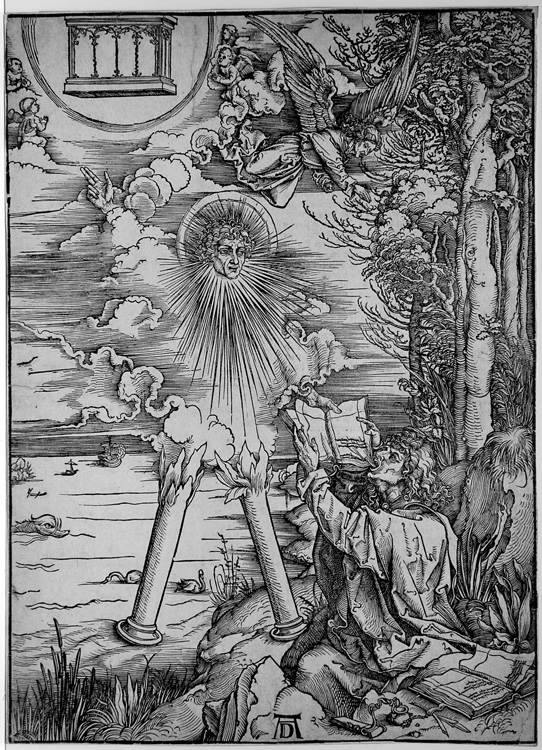 |
|
|
|
Albrecht Durer (Nuremburg, 1471-1528), St. John devouring the Book (Bartsch 70, Strauss 53, Meder 172). Original woodcut, c. 1497-98 for The Apocalypse. The work draws details from Revelations 10. Original woodcut from the 1498 German edition of The Apocalypse, which Meder describes (Strauss, p. 155) as "Carefully printed and very rare." He also calls it (Strauss, p. 196) "clear and bright; brilliant; rarely with full borders; frequently with three breaks in the right portion of the lower border; gaps in the left border below the small angel; also opposite on the right border." Our impression is before the breaks lower right and with only one small break in the left border below the small angel. We also have full borders top, bottom, and left; the right edge seems to have been slightly trimmed, but there is still some border visible. Repaired tear upper center to the right of the border, small restored upper and lower right corners. The German text verso exactly matches the reproduction illustrated in the 1964 facsimile of the 1498 German text of the Apocalypse (although our impression is better than the one illustrated in the work). Strauss comments, "If a mystery can be made plausible, then Dürer has succeeded . . . in doing just that. He renders the incredible credible, retains the mysterious, and yet invites the viewers to interpret and understand what is happening. As a means to this end, he has invented a new graphic language" (p. 195). Image size: 390x280mm. Price: Please call or email for current pricing information.
|
|
|
|
|
|
2009-2010 were also good times to go see shows featuring Old Master Drawings. The Metropolitan Museum of Art offered a show featuring Bronzino's compete drawings (catalogue raisonné available from the Metropolitan Bookstore) and the Morgan Library offered Rome After Raphael, a wonderful collection of works from Raphael and Michelangelo through Annibale Carracci and featuring drawings by Parmigianino and Giulio Clovio as well as many drawings from the members of Raphael's studio, including Giulio Romano and Perino del Vaga. Both were very rich shows and impossible to digest in only one viewing, so we saw each of them three times. From the Bronzino show, we got a sense of the quality difference between drawings by the same master. Some were finished works able to stand alone without reference to particular paintings, others were quick sketches full of first ideas and alternative possibilities; from the show at the Morgan, we took a way an admiration for the work that even lesser known artists were capable of rising to achieve. In the past, I think a lot of critics were inclined to favor works that had links to paintings; some of the pieces in both shows, however, offered opportunities to delight in the spontaneity of drawings done for the pleasure of the artist or as a gift to a patron being wooed for a commission.
|
|
|
|
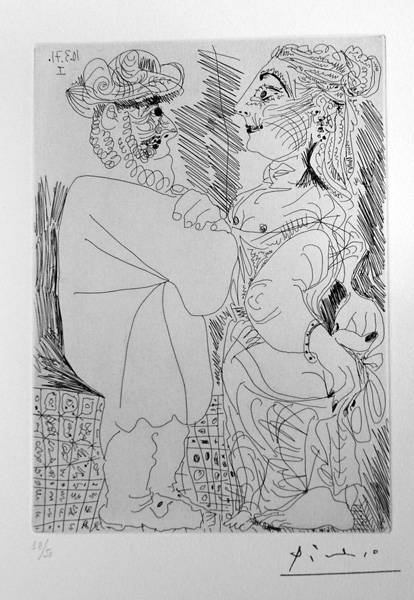 |
|
|
|
Series 156: 70. Artist and Model (Bloch 1927, Baer 1936). Original etching, 1971. 50 numbered impressions signed with the estate signature stamp. Executed 3/10/71 and approved by Picasso before his death, this etching, like the others in this series, was printed posthumously. An artist watches a beautiful young model with her arms attached backwards. Most of the etchings in the 156 Series show artists (including Raphael, Rembrandt, Degas, and Picasso himself). often aged, looking at their beautiful young models. Here the artist, perhaps Rembrandt, who appears to be wearing 17th-century buckles on his boots, seems to be focused on the woman's eyes to the exclusion of all other aspects of her which are amply, if oddly, revealed. Image size: 210x150mm. Price: Please call or email for current pricing information.
|
|
|
|
|
|
This year was also the year of Picasso in New York and Massachusetts. There were Picasso shows at the Marlborough Gallery on 57th St. just west of Fifth Avenue, the Metropolitan Museum, and the Museum of Modern Art. The Marlborough show featured over 200 etchings, linocuts, and lithographs ranging in date from 1905 to 1968, including many of the greatest pieces from the Suite Vollard (1935) and a large number of pieces from the Suite 347 (1968). We greatly admired the Suite Vollard pieces, especially the Minotaur sequence, but found the Suite 347 pieces mostly lacking in delight and intensity. Interestingly, the Metropolitan's show, although it included many paintings and drawings also had a very large print component, including many from the Suite 347. Interestingly, the Suite 347 etchings in the Met gave a completely different sense of the series. Many of them were much more complex, full of wit and, if not joy outright, the memory of past joys. It reminded us what a difference selection can make when evaluating part of a series of artworks. Works at the Met, of course, were not priced since they were not for sale; prices at the Marlborough Gallery were available on a separate list, available at the desk. Searching for pieces comparable to our etchings from the Series 156, I was impressed by 4 small etchings dated 1932 but not printed until 1961 and published in 1981 by Galerie Louise Leiris, Picasso's longtime gallery, in a stamp-signed edition of 50 (from a total edition of 69): Please call or email for current pricing information, Please call or email for current pricing information, Please call or email for current pricing information, and Please call or email for current pricing information (the last for a piece approximately 116x116mm). Click here for our other etchings from the Series 156, described by The Art Newspaper, n. 130 for November 2002, p. 49 as follows: "A high proportion of works were from Picasso's two late series, 347 and 156, executed shortly before his death in 1971. Traditionally, these prints have not been as highly regarded as the earlier etchings of the Suite Vollard, and this, coupled with the fact that there are so many of them, means that prices are still extremely reasonable [meaning, we learn later in the article, that "about 60% of the prints can still be bought for under £10,000" [then in the neighborhood of Please call or email for current pricing information].
|
|
|
|
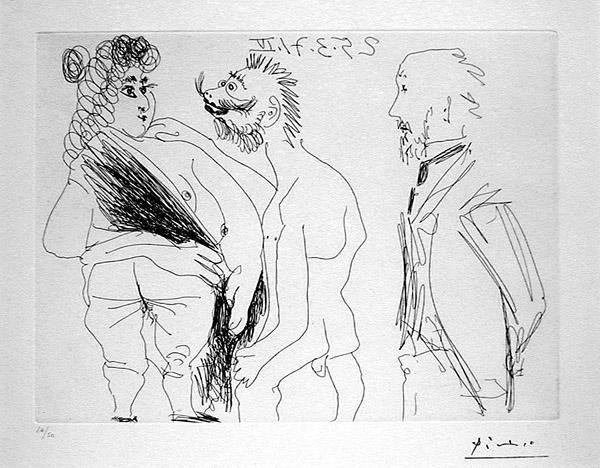 |
|
|
|
Series 156: 95. Degas in the Bordello (Bloch 1950, Baer 1959). Original etching, 1971. 50 numbered impressions signed with the estate signature stamp. Executed 3/25/71 and approved by Picasso before his death, this etching, like the others in this series, was printed posthumously. Here Degas watches a patron of a bordello with one of the objects of his lust. Note the brutishness of the male customer in the brothel oblivious to the cooly-observing artist. Image size: 230x310mm. Price: Please call or email for current pricing information.
|
|
|
|
Spaightwood Galleries, Inc.
To purchase, call us at 1-800-809-3343 (1-508-529-2511 in Upton MA & vicinity) or send an email to spaightwood@gmail.com.
We accept AmericanExpress, DiscoverCard, MasterCard, and Visa.
We also accept wire transfers and paypal.
For directions and visiting information, please call. We are, of course, always available over the web and by telephone (see above for contact information). Click the following for links to past shows and artists. For a visual tour of the gallery, please click here. For information about Andy Weiner and Sonja Hansard-Weiner, please click here. For a list of special offers currently available, see Specials.
All works are sold with an unconditional guarantee of authenticity (as described in our website listing).
Copyright 2004-2017, Spaightwood Galleries, Inc.
Go back to the top of this page.
Visiting hours: Saturday 10:00 am to 5:00 pm and Sunday noon to 6:00 pm and other times by arrangement.
Please call to confirm your visit. Browsers and guests are welcome.
|
|
|
|
|
|
|
|
|
|
|
|
|
|
|
|
|
|
|
|
|
|
|
|
|
|
|
|
|
|
|
|
|
|
|
|
|
|
|
|
|
|
|
|
|
|
|
|
|
|
|
|
|
|
|
|
|
|
|
|
|
|
|














